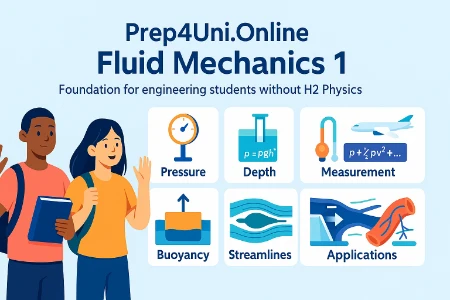Purpose:
To support students with limited physics background by covering essential topics foundational to engineering studies. This course is ideal for students entering engineering programmes who did not take H2 Physics or an equivalent subject at A Level.

A clean, student-focused illustration promoting Prep4Uni.Online — Fluid Mechanics 1, a foundations course designed for entrants to engineering who did not take H2 Physics (or equivalent). The artwork highlights the course arc—
- Pressure: definition, SI units, gauge vs absolute.
- Variation with depth: \( p = p_{0} + \rho g h \) and standard hydrostatic problems.
- Pressure measurement: U-tube / inclined manometers, Bourdon gauges, piezoelectric sensors.
- Buoyancy: Archimedes’ principle, flotation and stability.
- Fluid dynamics basics: streamlines; flow rate \( Q \); continuity \( A_{1}v_{1} = A_{2}v_{2} \) (equivalently \( \rho A v = \mathrm{const} \)); laminar vs turbulent regimes.
- Bernoulli’s equation: \[ p + \frac{1}{2}\rho v^{2} + \rho g h = \mathrm{const} \] with assumptions and typical uses (Pitot, Venturi).
- Applications: nozzles and pipes, dam loading, wing lift, and blood flow.
Perfect for a course hero or banner where the goal is to signal “clear concepts, worked practice, and real-world relevance.”
Chapter 1: Pressure
Overview: Introduce the concept of pressure in fluids, its definition, SI unit (Pa), and the distinction between gauge and absolute pressure.- Define pressure \( p=\frac{F}{A} \) and recognize its scalar nature.
- Convert between pascals, bar \( \big(1~\text{bar}=10^{5}\,\text{Pa}\big) \) and atm \( \big(1~\text{atm}=1.01325\times10^{5}\,\text{Pa}\big) \).
- Explain gauge vs. absolute pressure: \( p_{\text{abs}}=p_{\text{atm}}+p_{\text{gauge}} \).
Chapter 2: Variation of Pressure with Depth
Overview: Derive how pressure increases linearly with depth in a static fluid, culminating in \( p = p_{0} + \rho g h \).- Apply \( p=\rho g h \) to calculate pressure at depth \(h\) below a free surface at atmospheric pressure.
- Account for varying surface pressure \( p_{0} \) using \( p(h)=p_{0}+\rho g h \).
- Solve hydrostatic–pressure problems in liquids of uniform density \( \rho \).
Chapter 3: Pressure Measurement
Overview: Explore common pressure–measurement devices—manometers, Bourdon gauges, and piezoelectric sensors—and how to read them.- Interpret U-tube and inclined-tube manometer readings using \( \Delta p = \rho g\,\Delta h \) (and multi-fluid variants).
- Understand how a Bourdon gauge translates pressure into pointer deflection.
- Compare advantages of mechanical vs. electronic sensors (range, accuracy, dynamic response).
Chapter 4: Buoyant Forces & Archimedes’ Principle
Overview: Show that a body immersed in a fluid experiences an upward buoyant force equal to the weight of displaced fluid, and apply it to floating and submerged objects.- State and apply Archimedes’ principle: \( F_{B}=\rho_{f} g V_{\text{disp}} \).
- Calculate buoyant force on fully and partially submerged bodies.
- Determine conditions for flotation and stability (e.g. \( W=F_{B} \); introductory metacentric ideas).
Chapter 5: Fluid Dynamics
Overview: Begin the study of flowing fluids by introducing streamlines, flow rate \(Q\), the continuity equation, and laminar vs. turbulent regimes.- Define volumetric flow \( Q=\frac{dV}{dt}=A v \) and mass flow \( \dot{m}=\rho Q \).
- Use continuity (incompressible) \( A_{1}v_{1}=A_{2}v_{2} \); for variable density \( \rho_{1}A_{1}v_{1}=\rho_{2}A_{2}v_{2} \).
- Classify laminar vs. turbulent flow with Reynolds number \( \mathrm{Re}=\frac{\rho v D}{\mu} \).
Chapter 6: Bernoulli’s Equation
Overview: Derive Bernoulli’s equation from energy conservation for inviscid, incompressible, steady flow and apply it to common problems (e.g. Pitot tube, Venturi).- Derive \( p + \frac{1}{2}\rho v^{2} + \rho g h = \text{constant} \) along a streamline; head form \( \frac{p}{\rho g}+\frac{v^{2}}{2g}+h=\text{constant} \).
- Solve Bernoulli problems with varying heights and velocities, e.g. Pitot speed \( v=\sqrt{\frac{2\,(p_{0}-p)}{\rho}} \).
- Recognize assumptions and limitations (steady, incompressible, inviscid; no shaft work/heat between stations).
Chapter 7: Applications of Fluid Dynamics
Overview: Tie everything together through real-world applications: flow through nozzles, loading on dams, lift on airplane wings, and blood flow in arteries.- Model flow through converging/diverging pipes using continuity and \( \Delta p=\frac{1}{2}\rho\,(v_{2}^{2}-v_{1}^{2}) \) (horizontal).
- Compute lift using pressure differences (Bernoulli) together with circulation ideas \( L’=\rho \Gamma V \).
- Analyze simple bio-fluid problems using \( Q=A v \), \( \Delta p=\rho g \Delta h \), and Bernoulli where applicable.
Additional Resources:
Notes:
Fluid Mechanics 1 is self-paced — take your time, and return as often as needed!
Links to other pages outside this course that provide broader coverage on some of the relevant concepts are provided.
Next Steps
Start with Chapter 1: Pressure
Read each concept section carefully
Try the included EXERCISERS which include Questions (Answers are provided) and Problems (Solutions are provided) to test your understanding. However, please attempt those questions and problems before looking at the answers and solutions.
Bookmark sections of difficulty and return after attempting later topics
